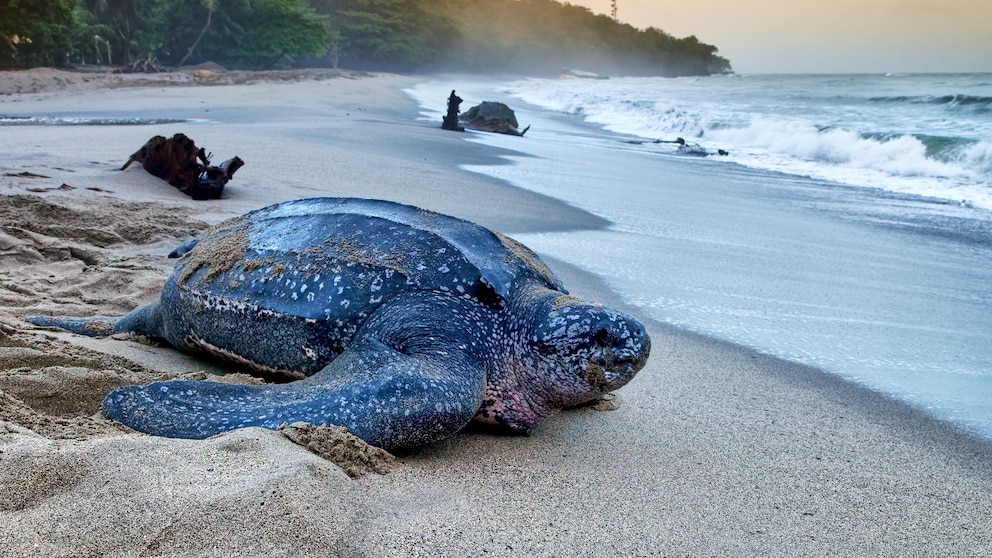October 2, 2024, 9:41 am | Read time: 4 minutes
Turtles are fascinating animals. They are surviving reptiles from prehistoric times and come in a wide range of sizes. PETBOOK has summarized six exciting facts about the leatherback turtle in this article.
There are currently 360 known species of turtle, with over 200 subspecies. These include soft-shelled turtles, aquatic turtles, giant tortoises and sea turtles. Although the leatherback turtle is not zoologically part of the sea turtle family, it is often grouped with them in the superfamily Chelonioidea. However, there are many other exciting facts about this reptile, such as its impressive size.
1. The largest turtle in the world
The leatherback turtle can reach a carapace length of up to 2.5 meters (8.2 feet) and weigh as much as 700 kilograms (1543 pounds). This makes it the largest living turtle in the world. The largest and heaviest specimen ever found had a shell length of 256 centimeters (8.4 feet) and weighed 916 kilograms (2019 pounds).
2. A unique shell
Usually, the shells of sea turtles consist of horny scales. However, the shell of the leatherback turtle is composed of small, loosely connected bones held together by dark gray or blue-blackish skin. This skin is relatively thin but leathery and gives the animals their name.
Their carapace is elongated and tapers towards the end. On the back of the leatherback turtle are seven bony plates called keels. These run from the turtle’s head to its rump and give the impression that the animal’s shell is sewn together from individual strips of leather.
Another unique feature of the leatherback turtle is that it cannot pull its head into its shell.
3. At home almost everywhere
The leatherback turtle can be found in all tropical and subtropical seas. This means that it has the most widespread habitat of all reptiles. However, its fat layer and dark skin color allow it to live in colder water. Its ability to keep its body temperature up to 18 degrees above the water temperature also helps. As a result, the animals can also be found in colder areas, such as off the coast of Scotland, where specimens have been spotted more frequently.
In 2023, a leatherback turtle even strayed into the North Sea and was unfortunately found dead on the beach of the Elbe. However, this only happens rarely.
4. Highly endangered
Unfortunately, the leatherback turtle is highly endangered. The reasons for this are fishing, the removal of eggs from the nests for consumption, and the targeted hunting of the animals. The latter is increasingly taking place in the Indian state of Tamil Nadu. There, people use the oil extracted from their shells to seal their wooden boats.
However, marine pollution poses the greatest danger to turtles. They get entangled in drifting nets, long lines and cords and suffocate miserably underwater due to lack of air. Consuming plastic waste, which they mistake for jellyfish, also harms turtles and can lead to their death.
According to information from the Research and Rehabilitation Center for Sea Turtles in La Rochelle, 68 leatherback turtles were washed up on the French Atlantic coast in 2019. Plastic waste was found in half of their digestive tracts.
5. Excellent divers
Leatherback turtles are not only good swimmers but also excellent divers. While other sea turtle species can only dive to depths of around 200 meters, they can dive to depths of up to 1200 meters. Their soft and flexible shell, which can both contract and expand under strong water pressure, helps them do this. However, to dive this deep, leatherback turtles use a special technique to reduce their lung volume significantly. This makes them substantially heavier than the surrounding water and allows them to glide effortlessly into the depths.
6. Faster Than You Think
Turtles are often associated with a certain sluggishness. This may be true for many species – especially on land. However, the leatherback turtle is faster in the water than you might imagine. While it usually travels at a leisurely speed of two to 19 km/h (1.2 to 11.8 mph), it can reach speeds of up to 35 km/h (21.7 mph) if necessary. This makes it as fast as the world’s swiftest penguin, the gentoo penguin, despite being significantly larger and heavier.

Turtle sets a new diving record

The 8 slowest animals in the world

Ghostly new shark species discovered in the deep sea
Sources
- stiftung-meeresschutz.org, “Leatherback turtle” (accessed on 23.03.2024)
- tierenzyklopaedie.de, “Leatherback turtle (Dermochelys coriacea” (accessed on 23.03.2024)
- conserveturtles.org, “Information About Sea Turtles: Leatherback Sea Turtle” (accessed 23.03.2024)
- tierchenwelt.de, “Leatherback Sea Turtle” (accessed on 23.03.2024)
- ndr.de, “Leatherback Turtle from the North Sea: What’s Next?” (accessed on 23.03.2024)

